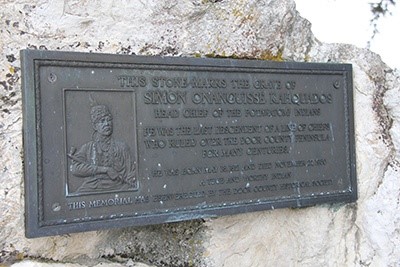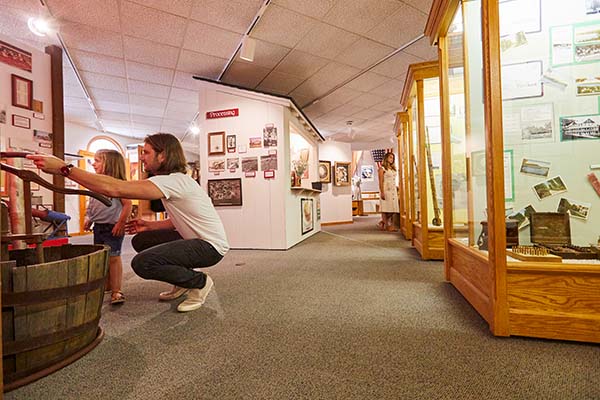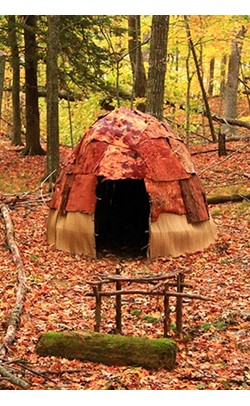
Indigenous Peoples' Historical Sites
A Key Piece of Local History
The history and influence of Paleo-Indians and Indigenous Peoples in Door County can be seen in countless places, and there are a handful of spots where visitors can take a deeper dive into the lives of the region's early inhabitants, including viewing artifacts and historically significant sites. At these five locations, travelers can spend time appreciating the people who came before us and on whose land we work, live, play, and visit.
5 Historical Sites to Visit & Reflect On

1. Replica Indigenous Peoples' Settlement at Whitefish Dunes
A re-creation of an indigenous peoples' settlement in the woods of Whitefish Dunes State Park features replica wigwam structures and prehistoric tools.

2. Paleo-Indian Campsite in Sturgeon Bay

3. Chief Oshkosh's Trading Post in Egg Harbor

4. Door County Historical Museum in Sturgeon Bay
Deeper Dive: First Nations History in Door County
1. Whitefish Dunes State Park (Sturgeon Bay)
At this lakeside park, visitors can be transported back to Door County's earliest days to see a re-creation of a Indigenous Peoples' settlement, including replica wigwam structures and prehistoric tools. The park’s nature center also houses several hand-painted murals depicting scenes from the lives of these first inhabitants.
While performing archaeological digs on the land that's now the state park, scientists have discovered artifacts that indicate eight different groups made their homes here over the centuries. The Potawatomi were the first and primary denizens of this area, but other nations such as the Winnebago, Ojibwe, Sauk, and Menominee also established permanent or semi-permanent homesteads here.
2. Cardy Paleo-Indian Campsite (West Sturgeon Bay)
This site marks the spot where Door County resident Darrel Cardy’s family farm once stood and where he gathered a huge collection of Paleo-Indian artifacts over his lifetime.
Thanks to Cardy's persistence, scientists eventually came to the Sturgeon Bay site to perform an archaeological dig where even more relics were uncovered. There it was confirmed that Indigenous Nations settled this land and left behind Clovis points, hunting tools, scrapers, and other artifacts dating back more than 10,000 years. Further, these digs proved that Indigenous Peoples had lived much further north and were in the area much earlier than previously thought.
Today, the site features a historical marker and a kiosk with photographs and detailed information about the scientific discovery of the items, their historical significance, and the history of Indigenous Peoples in the area.
3. Site of Chief Oshkosh's Trading Post (Egg Harbor)
Chief Roy Oshkosh of the Menominee Nation is an icon in Door County known as a passionate advocate for both the region and the Menominee people. The official "first ambassador" of the county, Oshkosh was well known for his vibrant personality, quick wit, and fierce love of the Door peninsula and Washington Island. He is also remembered for his lively powwows that attracted locals and visitors alike and showcased authentic Menominee drumming, dancing, clothing, and storytelling.
After arriving in Egg Harbor in the late 1930s and working in the shipbuilding industry, Oshkosh located a spiritual place in Door County that his grandmother used to tell him about, "where the water flowed through a wooded glen and disappeared never to be seen again" (Door County Pulse). He eventually found the beautiful creek-side site, purchased it, and re-established it not only as his homestead but a trading post and a museum of Menominee art and relics.
These days, the trading post and other structures Oshkosh built still stand. Visitors can stop at this historic site in Egg Harbor where Chief Oshkosh worked so hard to honor and do right by his people. The trading post continues to sell jewelry, music, books, art, baskets, and more, and travelers can also see a statue of Oshkosh built in 1985 and the amphitheater where he held his famous powwows.
4. Door County Historical Museum (Sturgeon Bay)
In addition to the Paleo-Indian site at Crossroads, visitors can learn about Darrel Cardy’s collection of Indigenous Peoples' artifacts at the Door County Historical Museum in Sturgeon Bay. Cardy donated the collection, and it is now a permanent exhibit among the museum’s other Indigenous Peoples' artifacts, which include centuries-old textiles, clothing, tools and other items.
The Cardy collection “contains fluted spear points, end scrapers, flake tools and various other artifacts...much older than the stone tools used by the Indigenous Peoples who were encountered by the earliest European explorers” (Door County Pulse).
Sources & Further Reading
The First Door County Residents (Door County Pulse)
Pre-Native American Tools Found in Sturgeon Bay (Green Bay Gazette)
History of Immigrants to Southeastern Wisconsin (Door County Library)
Remembering the Life of Simon Kahquados (WXPR Public Radio)
Chief Roy Oshkosh: Door County's Unlikely Ambassador (Door County Pulse)
Indigenous Peoples of Door County

Discover Door County
Newsletter



